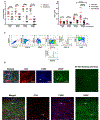Production of the Cytokine VEGF-A by CD4+ T and Myeloid Cells Disrupts the Corneal Nerve Landscape and Promotes Herpes Stromal Keratitis
- PMID: 33207210
- PMCID: PMC7682749
- DOI: 10.1016/j.immuni.2020.10.013
Production of the Cytokine VEGF-A by CD4+ T and Myeloid Cells Disrupts the Corneal Nerve Landscape and Promotes Herpes Stromal Keratitis
Abstract
Herpes simplex virus type 1 (HSV-1)-infected corneas can develop a blinding immunoinflammatory condition called herpes stromal keratitis (HSK), which involves the loss of corneal sensitivity due to retraction of sensory nerves and subsequent hyperinnervation with sympathetic nerves. Increased concentrations of the cytokine VEGF-A in the cornea are associated with HSK severity. Here, we examined the impact of VEGF-A on neurologic changes that underly HSK using a mouse model of HSV-1 corneal infection. Both CD4+ T cells and myeloid cells produced pathogenic levels of VEGF-A within HSV-1-infected corneas, and CD4+ cell depletion promoted reinnervation of HSK corneas with sensory nerves. In vitro, VEGF-A from infected corneas repressed sensory nerve growth and promoted sympathetic nerve growth. Neutralizing VEGF-A in vivo using bevacizumab inhibited sympathetic innervation, promoted sensory nerve regeneration, and alleviated disease. Thus, VEGF-A can shape the sensory and sympathetic nerve landscape within the cornea, with implications for the treatment of blinding corneal disease.
Keywords: CD4+ T cells; HSV-1; VEGF-A; cornea; myeloid cells; neuro-immune axis; sensory nerves; sympathetic nerves.
Copyright © 2020 Elsevier Inc. All rights reserved.
Conflict of interest statement
Declaration of Interests The authors declare no competing interests.
Figures






References
-
- Acosta MC, Tan ME, Belmonte C, and Gallar J (2001). Sensations evoked by selective mechanical, chemical, and thermal stimulation of the conjunctiva and cornea. Invest Ophthalmol Vis Sci 42, 2063–2067. - PubMed
-
- Reeves Alexander G., R.S.S., Cohen Jeffrey, Fadul Camilo, Jenkyn Lawrence, Ward Thomas Facial sensations & movements In Disorders of the nervous system, Swenson RS, ed. (Dartmouth Medical School; ).
-
- Arganda-Carreras I, Fernandez-Gonzalez R, Munoz-Barrutia A, and Ortiz-De-Solorzano C (2010). 3D reconstruction of histological sections: Application to mammary gland tissue. Microsc Res Tech 73, 1019–1029. - PubMed
Publication types
MeSH terms
Substances
Grants and funding
LinkOut - more resources
Full Text Sources
Molecular Biology Databases
Research Materials

